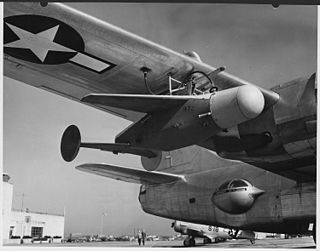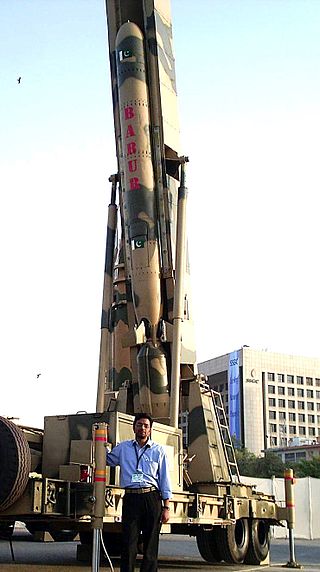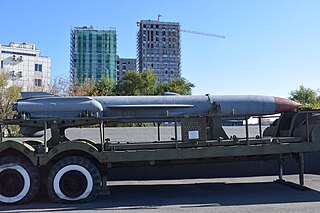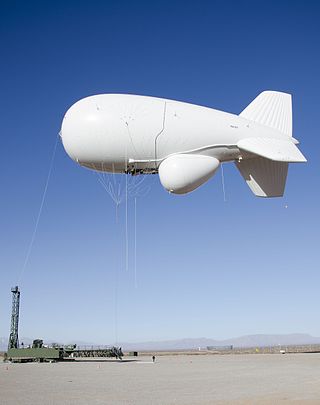
A cruise missile is an unmanned self-propelled guided vehicle that sustains flight through aerodynamic lift for most of its flight path and whose primary mission is to place an ordnance or special payload on a target. Cruise missiles are designed to deliver a large warhead over long distances with high precision. Modern cruise missiles are capable of traveling at high subsonic, supersonic, or hypersonic speeds, are self-navigating, and are able to fly on a non-ballistic, extremely low-altitude trajectory.

The P-15 Termit is an anti-ship missile developed by the Soviet Union's Raduga design bureau in the 1950s. Its GRAU designation was 4K40, its NATO reporting name was Styx or SS-N-2. China acquired the design in 1958 and created at least four versions: the CSS-N-1 Scrubbrush and CSS-N-2 versions were developed for ship-launched operation, while the CSS-C-2 Silkworm and CSS-C-3 Seersucker were used for coastal defence. Other names for this basic type of missile include: HY-1, SY-1, and FL-1 Flying Dragon, North Korean local produced KN-1 or KN-01, derived from both Silkworm variants and Russian & USSR P-15, Rubezh, P-20 P-22.

The BAe Sea Eagle is a medium-weight sea-skimming anti-ship missile designed and built by BAe Dynamics. It is designed to sink or disable ships up to the size of aircraft carriers in the face of jamming and other countermeasures including decoys. Its users include the Royal Air Force and Royal Navy, the Royal Saudi Air Force, and the Indian Navy.

Active radar homing (ARH) is a missile guidance method in which a missile contains a radar transceiver and the electronics necessary for it to find and track its target autonomously.

The Crotale is a French, all-weather, short-range surface-to-air missile system developed to intercept airborne ranged weapons and aircraft, from cruise or anti-ship missiles to helicopters, UAVs or low-flying high-performance fighter aircraft. It was developed by Thomson CSF Matra and consists of a mobile land-based variant as well as various naval ones.

The Babur is an all-weather, subsonic cruise missile developed and designed by the National Defence Complex (NDC) of Pakistan.

The four De Zeven Provinciën-class frigates are air-defence and command frigates in service with the Royal Netherlands Navy. This class of ships is also known as "LCF". The ships are similar to the German Sachsen-class frigates in role and mission.

The Kh-59 Ovod is a Russian cruise missile with a two-stage solid-fuel propulsion system and 200 km range. The Kh-59M Ovod-M is a variant with a bigger warhead and turbojet engine. It is primarily a land-attack missile; the Kh-59MK variant targets ships.

The Zvezda Kh-35 is a Soviet turbojet subsonic cruise anti-ship missile. The missile can be launched from helicopters, surface ships and coastal defence batteries with the help of a rocket booster, in which case it is known as Uran or Bal. It is designed to attack vessels up to 5,000 tonnes.

The Korean People's Army Air Force is the unified military aviation force of North Korea. It is the second largest branch of the Korean People's Army comprising an estimated 110,000 members. As of 2024, it is estimated to possess some 570 combat aircraft, 200 helicopters, and a few transporters, mostly of decades-old Soviet and Chinese origin. Its primary task is to defend North Korean airspace. In April 2022, the Korean People's Army Air and Anti-Air Force name was changed to Korean People's Army Air Force.

The P-70 Ametist was an anti-ship missile carried by Soviet and Indian Project 670 submarines, as well as the Soviet Project 661 Anchar. It was soon succeeded by the P-120 Malakhit (SS-N-9 'Siren').

The RIM-174 Standard Extended Range Active Missile (ERAM), or Standard Missile 6 (SM-6), is a missile in current production for the United States Navy (USN). It was designed for extended-range anti-air warfare (ER-AAW) purposes, providing capability against fixed and rotary-wing aircraft, unmanned aerial vehicles, anti-ship cruise missiles in flight, both over sea and land, and terminal ballistic missile defense. It can also be used as a high-speed anti-ship missile. The missile uses the airframe of the earlier SM-2ER Block IV (RIM-156A) missile, adding the active radar homing seeker from the AIM-120C AMRAAM in place of the semi‑active seeker of the previous design. This will improve the capability of the Standard missile against highly agile targets and targets beyond the effective range of the launching vessels' target illumination radars. Initial operating capability was planned for 2013 and was achieved on 27 November 2013. The SM-6 is not meant to replace the SM-2 series of missiles but will serve alongside and provide extended range and increased firepower. It was approved for export in January 2017. An air-to-air variant of the SM-6, known as the AIM-174, is the first dedicated long-range air-to-air missile employed by the USN since the 2004 retirement of the AIM-54 Phoenix. SM-6 can also be fired from the U.S. Army's Typhon missile launcher as part of the Strategic Mid-range Fires System (SMRF).

The SSM-700K C-Star (Haeseong) is a ship-launched sea-skimming surface-to-surface anti-ship cruise missile developed by the South Korean Agency for Defense Development (ADD), LIG Nex1 and the Republic of Korea Navy in 2003. The missiles have deployed on KDX-II and KDX-III destroyers as of 2006, each carrying 8 and 16 of the missiles respectively, and on Ulsan-class frigates.

The AGM-158C LRASM is a stealth air launch anti-ship cruise missile developed for the United States Air Force and United States Navy by the Defense Advanced Research Projects Agency (DARPA). Derived from the AGM-158B JASSM-ER, the LRASM was intended to pioneer more sophisticated autonomous targeting capabilities than the U.S. Navy's current Harpoon anti-ship missile, which has been in service since 1977.

The K-300PBastion-P is a Russian mobile coastal defence missile system. The system was developed together with the Belarusian company Tekhnosoyuzproekt.

The Korean People's Army Navy (KPANF; Korean: 조선인민군 해군; Hanja: 朝鮮人民軍 海軍; MR: Chosŏn-inmingun Haegun; lit. Korean People's Military Navy; or the Korean People's Navy, is the naval component of the Korean People's Army, the North Korean armed forces.

The Joint Land Attack Cruise Missile Defense Elevated Netted Sensor System, or JLENS, was a tethered aerial detection system designed to track boats, ground vehicles, cruise missiles, manned and unmanned aircraft, and other threats. The system had four primary components: two tethered aerostats which utilized a helium/air mix, armored mooring stations, sophisticated radars, and a processing station designed to communicate with anti-missile and other ground and airborne systems. Each system was referred to as an "orbit", and two orbits were built. The Army-led joint program which fielded JLENS was designed to complement fixed-wing surveillance aircraft, saving money on crew, fuel, maintenance and other costs, and give military commanders advance warning to make decisions and provide notifications. Following cost overruns, underperformance, declining support in Congress, and public scrutiny following a snapped tether which allowed one craft moored at Aberdeen Proving Ground, Maryland to drift on a 100-mile uncontrolled descent across Pennsylvania, dragging its cable tether which damaged power lines and cut power to 20,000 homes, the program was suspended in October 2015, and completely discontinued by 2017.

The KN-09 (K-SS-X-9) is a North Korean 300 mm rocket artillery system of a launcher unit comprising eight rockets packaged in two four-rocket pods.

The Hwasong-12 is a mobile intermediate-range ballistic missile developed by North Korea. The Hwasong-12 was first revealed to the international community in a military parade on 14 April 2017 celebrating the Day of the Sun which is the birth anniversary of North Korea's founding President, Kim Il Sung. North Korea tested Hwasong-12 on 30 January 2022.


















